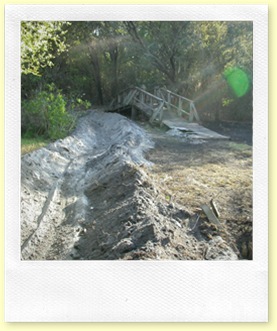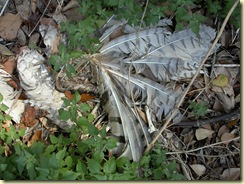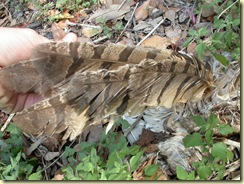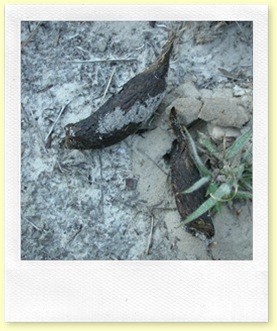Follow the epic tale of restoration and conservation of an urban forest on the campus of the Museum of Science & Industry in Tampa.
Tuesday, March 31, 2009
Flora and Fauna of the Back Woods
Wednesday, March 18, 2009
Plow Line Clean-up
We are in need of volunteers to help us fill in the plow lines cut in to contain our recent brush fire. The level of activity is moderate. We will be using hand tools (shovels, rakes, etc) to fill and level the soil surface where the plow lines were cut. If you are interested in participating in reoccurring volunteer service as a Back Woods Forest Steward, please email me at crhodes@mosi.org.
Tuesday, March 17, 2009
MOSI Wildfire Video
Tampa Fire Rescue copy: On 3/14/09 about 1340 hrs TFR units responded to a brush fire in the wooded area behind the Museum of Science and Industry, 4801 E Fowler Avenue. On scene fire crews reported smoke coming from the woods about 100 feet into the tree line, they estimated about 2 acres to be burning. It took about 90 minutes to bring the fire under control, no injuries were reported.
An Investigator from the Tampa Fire Marshals Office is on scene looking into the fire cause.
Fire crews worked quickly to make sure the flames did not interrupt the Renaissance Festival occurring at the edge of the woods. Some smoke went into the festival area, there was no interruption to the festival or MOSI.
After fire crews used brush trucks to access the burning area and knock down the fire a tractor from the Division of Forestry arrived on scene to cut a fire break around the burnt area. Nearly 3 acres burnt.
About 8 firefighting units from Tampa, Temple Terrace, the Division of Forestry and Hillsborough County were on scene.
Saturday, March 14, 2009
Wildfire in the Back Woods
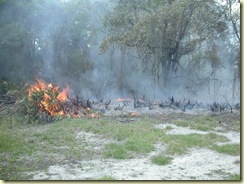
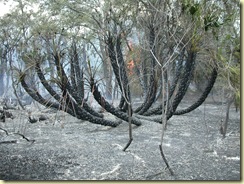 Got a call this afternoon around 2pm from my boss telling me there was a wildfire in the Back Woods. Local fire departments were already on scene and working to cut fence and get hose and people into the fire by the time I received the call. Dashing out to the woods as fast as the gator would carry me; I was able to capture a few photos of some active fire at the end of the event and before the local FD asked me to leave. The big palmetto is on the north side of the big sink hole.The composite shot is from the center of the big sink hole. The Division of Forestry was on hand at the end of the day to help with the mop up and put a plow line in around the fire to prevent it from spreading from the containment area from any flame-ups tonight or tomorrow. Needless to say we have some fairly significant damage from the plow lines. Volunteers will be needed to do some plow line restoration. Interested? Email me!
Got a call this afternoon around 2pm from my boss telling me there was a wildfire in the Back Woods. Local fire departments were already on scene and working to cut fence and get hose and people into the fire by the time I received the call. Dashing out to the woods as fast as the gator would carry me; I was able to capture a few photos of some active fire at the end of the event and before the local FD asked me to leave. The big palmetto is on the north side of the big sink hole.The composite shot is from the center of the big sink hole. The Division of Forestry was on hand at the end of the day to help with the mop up and put a plow line in around the fire to prevent it from spreading from the containment area from any flame-ups tonight or tomorrow. Needless to say we have some fairly significant damage from the plow lines. Volunteers will be needed to do some plow line restoration. Interested? Email me!
Wednesday, March 11, 2009
Owl Remnants
Sadly one of our forest sentinels is silently composting in the Back Woods. I am not completely positive of the identification. I am pretty sure it is either a barred owl or a great horned owl, both of which have been documented using the Back Woods. Any birders out there who could confirm the id? Sigh.
One Man’s Weed
Lots of lovelies are peeking out some blossoms in the Back Woods. You may be familiar with some of these as common roadside weeds though they are shining here as welcome color in the woods. Here are just a few our spring early birds.
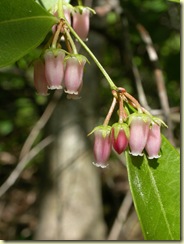 Shiny lyonia (Lyonia lucida) or one of the many plants called fetterbush. Shiny lyonia is the Ericaceae family commonly known as the heath family. You will find blueberries and and St John’s wort in this family as well. Notice how the flowers are similar to blueberries. In a previous post we pointed out the notable lateral vein on the outside edge of the leaf. This shot captures both the flowers and that distinguishable characteristic.
Shiny lyonia (Lyonia lucida) or one of the many plants called fetterbush. Shiny lyonia is the Ericaceae family commonly known as the heath family. You will find blueberries and and St John’s wort in this family as well. Notice how the flowers are similar to blueberries. In a previous post we pointed out the notable lateral vein on the outside edge of the leaf. This shot captures both the flowers and that distinguishable characteristic.
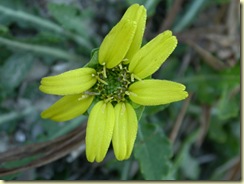 Florida greeneyes (Berlandiera subacaulis), a lovely little weed in the making it’s presence known in the sandhill.
Florida greeneyes (Berlandiera subacaulis), a lovely little weed in the making it’s presence known in the sandhill.
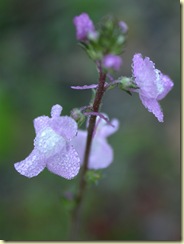 Some dew laden toadflax (Linaria canadensis) flowers. The family is a real mouthful…Scophulariaceae…gotta love it! Couldn’t you guess that common snapdragons are also found in this family. This diminutive flower is found in disturbed sites everywhere.
Some dew laden toadflax (Linaria canadensis) flowers. The family is a real mouthful…Scophulariaceae…gotta love it! Couldn’t you guess that common snapdragons are also found in this family. This diminutive flower is found in disturbed sites everywhere.
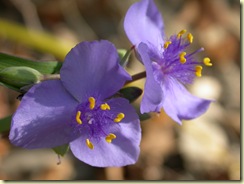 One of Kristen’s favorites is about to explode across the Back Woods. Spiderwort (Tradescantia ohiensis) really can’t be beat for putting on a spring show. The flower color is sometimes hard to capture (blues and purple often do not photograph true) but, I think we came pretty close here.
One of Kristen’s favorites is about to explode across the Back Woods. Spiderwort (Tradescantia ohiensis) really can’t be beat for putting on a spring show. The flower color is sometimes hard to capture (blues and purple often do not photograph true) but, I think we came pretty close here.
Tuesday, March 10, 2009
Sandhill Expansion
Saturday was an absolutely wonderful day spent with old friends and new. Members of the Caribbean Chapter (all of central to southern Florida and Puerto Rico) of the Society of American Foresters held their annual volunteer service day in the Back Woods @ MOSI. New volunteer Forest Stewards, George and Brian, joined us to learn some chainsaw skills and help in the cleanup.
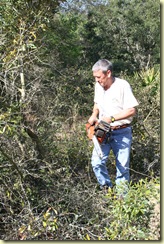 Priority of the day was to tackle the hardwoods (mostly sand live oak [Quercus geminata] and some black cherry [Prunus serotina] that are encroaching on the sandhill plant community. Commonly the canopy of trees in a sandhill community in our area might be dominated with longleaf pine (Pinus palustris) with a mix of a little turkey oak (Quercus laevis) , bluejack oak (Quercus incana), sand live oak, and others depending on the amount of disturbance (fire) the system is exposed to. Typically these systems are very open and subject to frequent low intensity fires that keep all but the fire resistant longleaf pine from dominating the canopy.
Priority of the day was to tackle the hardwoods (mostly sand live oak [Quercus geminata] and some black cherry [Prunus serotina] that are encroaching on the sandhill plant community. Commonly the canopy of trees in a sandhill community in our area might be dominated with longleaf pine (Pinus palustris) with a mix of a little turkey oak (Quercus laevis) , bluejack oak (Quercus incana), sand live oak, and others depending on the amount of disturbance (fire) the system is exposed to. Typically these systems are very open and subject to frequent low intensity fires that keep all but the fire resistant longleaf pine from dominating the canopy.
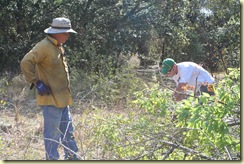 Needless to say their were some hardwoods shaking in their roots on Saturday. To the task; professional foresters (Sam), land managers (Stu), forestry consultants (Eric), and forestry students (Walter) broke out their chainsaws and starting clearing. Many thanks to SAF member Sam for sharing chainsaw skills with our volunteer Brian (we might even make him a forester). Some serious progress was made in the western sandhill. Unwanted hardwoods were cleared in the center and around the perimeter. This section is one of the few open areas in the forest still able to support herbaceous sandhill species and gopher tortoise.
Needless to say their were some hardwoods shaking in their roots on Saturday. To the task; professional foresters (Sam), land managers (Stu), forestry consultants (Eric), and forestry students (Walter) broke out their chainsaws and starting clearing. Many thanks to SAF member Sam for sharing chainsaw skills with our volunteer Brian (we might even make him a forester). Some serious progress was made in the western sandhill. Unwanted hardwoods were cleared in the center and around the perimeter. This section is one of the few open areas in the forest still able to support herbaceous sandhill species and gopher tortoise.
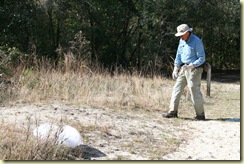 In addition to clearing trees, we cleared a serious amount of garbage from the sandhill. Volunteer George meticulously collected bags and bags of broken glass, mattress coils, and miscellaneous construction debris buried in the sandhill and more revealed by the clearing activities. There is still a disturbing amount of buried material throughout the forest but with our volunteers concerted efforts, the task is most definitely surmountable!
In addition to clearing trees, we cleared a serious amount of garbage from the sandhill. Volunteer George meticulously collected bags and bags of broken glass, mattress coils, and miscellaneous construction debris buried in the sandhill and more revealed by the clearing activities. There is still a disturbing amount of buried material throughout the forest but with our volunteers concerted efforts, the task is most definitely surmountable!
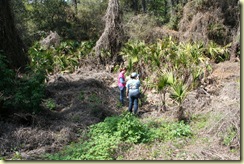 SAF members Mindy and Erin took on the task of recording GPS coordinates and conditions of the over 100 trees planted in January for MOSI’s Florida Arbor Day Celebration. Fortunately both Mindy and Erin participated in the January plantings and were familiar with the scattered locations of all the trees. Following the field collection, Mindy is collating all the data and producing GIS documents to analyze the data spatially(Thanks Mindy!). With this data, we hope to track the success of the planting and the future growth of the trees.
SAF members Mindy and Erin took on the task of recording GPS coordinates and conditions of the over 100 trees planted in January for MOSI’s Florida Arbor Day Celebration. Fortunately both Mindy and Erin participated in the January plantings and were familiar with the scattered locations of all the trees. Following the field collection, Mindy is collating all the data and producing GIS documents to analyze the data spatially(Thanks Mindy!). With this data, we hope to track the success of the planting and the future growth of the trees.
 We closed out the day hot and dusty. I thanked my friends for all their help and wished them well on their way home (some traveled over a hundred miles to join us for the day). I captured one last photo in the woods as everyone left. A honey bee on poison ivy (Toxicodendron radicans) blossoms signaling to me Spring is on the way and all is well with the woods.
We closed out the day hot and dusty. I thanked my friends for all their help and wished them well on their way home (some traveled over a hundred miles to join us for the day). I captured one last photo in the woods as everyone left. A honey bee on poison ivy (Toxicodendron radicans) blossoms signaling to me Spring is on the way and all is well with the woods.
Thursday, March 5, 2009

Wow, what a difference. Two new volunteer forest stewards Brian and George made a major dent in some of the demolition necessary in the Back Woods. The lush invasive filled picture shows our picnic platform in the western flatwoods. It was dilapidated, rotting out from underneath, and collapsing from soil subsidence.
Needless to say, it was in even worse shape than pictured here.
The second photo shows the fruits of some dedicated volunteer labor. New volunteer Brian (demolitionist extraordinaire) started his first day tackling the platform. On a second day he and new volunteer George (saw palmetto slasher extraordinaire) finished up the job! WooHoo! All that is left is some tidying up, repairing the waste can, and deciding on how to use the area in the future.
A comment on the brown: A fan to the MOSI Facebook page mentioned concern about the appearance of the Back Woods. Here is what I said in response; The Back Woods is undergoing an habitat restoration process which includes treating non native invasive plant species mechanically and with herbicides. Top that with a notable nippy and dry winter, and there appears to be a lot of brown in the Back Woods. Already we are seeing native shrubs and herbaceous material that was smothered by invasive competitive air potato vine making a come back even in this challenging weather. Please check out our forest blog TheLongleaf at http://thelongleaf.blogspot.com/ for more details about the restoration process. In addition to pictures on the blog, you can see more pictures of the Back Woods at our Flickr site MOSI Outside http://www.flickr.com/groups/mosioutside/ where you will definitely find plenty of beautiful things very much alive in the Back Woods.Thank you for your concern! Cheers, TheLongleaf
Beautiful Brambles
 The highbush or sawtooth blackberries (Rubus argutus [syn. betulifolius]) are starting to show some color (a little early it seems) in the Back Woods. And, of course we all know what follows is a juicy aggregate of drupelets we call a berry. Yum! This particular blackberry species is found throughout the Southeast in wet or dry areas and is commonly found in disturbed areas. Blackberries of all species are a very important group of plants to wildlife. The fruit is eaten by mammals and birds, the foliage is browsed deer and rabbits, and the thickets are refuge and nesting sites to many kinds of animals.
The highbush or sawtooth blackberries (Rubus argutus [syn. betulifolius]) are starting to show some color (a little early it seems) in the Back Woods. And, of course we all know what follows is a juicy aggregate of drupelets we call a berry. Yum! This particular blackberry species is found throughout the Southeast in wet or dry areas and is commonly found in disturbed areas. Blackberries of all species are a very important group of plants to wildlife. The fruit is eaten by mammals and birds, the foliage is browsed deer and rabbits, and the thickets are refuge and nesting sites to many kinds of animals.
Tuesday, March 3, 2009
Skyblue Beauty

A solitary skyblue lupine (Lupinus diffusus) is gracing us with bloom in the western sandhill. Skyblue lupine are found commonly throughout the state of Florida in sandhills and dry open hammocks. Popular with bees, the flowers have a pale blue corolla with a creamy white central spot. Even when not in bloom, they are easily recognizeable by their silky silvery haired foliage. Lupine are a member of the Fabaceae family (formerly Leguminosae) known commonly to many as the bean family or legumes. With a nod to Kristen over at the Lepcurious blog, lupine are in a sub order of legumes described as papilionaceous or having flowers that resemble a butterfly. Check out the MOSI Outside Flickr group for more pictures of the lupine and other great shots from the Back Woods, BioWorks butterfly garden, and the Richard T Bowers Historic Tree Grove
